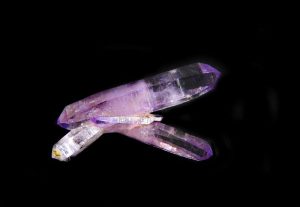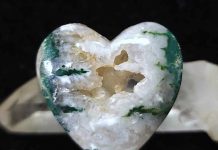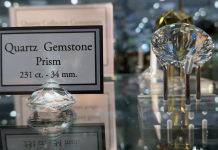
Amethyst has almost universal appeal. It is a favorite among jewelry enthusiasts, gem collectors and spiritual practitioners alike. With a wide range of hues from deep purple to soft lavender, this purple form of quartz (SiO2) has been popular since ancient times.
What’s in a Name?
Amethyst’s name is derived from the Greek word “amethystos,” which translates to “not drunken.” Legend has it that the young maiden, Amethyst, was on her way to pay tribute to the goddess Diana when she ran into the god Dionysus, the deity of wine and revelry. To protect her from Dionysus, Diana turned her into a pure crystalline quartz. A remorseful Dionysus spilled his wine over the stone giving it a purple hue. Because of this, Ancient Greeks thought that if you drank wine from a goblet fashioned out of amethyst you would not become drunk.

Richard Gross
Rock Science
With a Mohs hardness of seven, this purple quartz forms in geodes or cavities within rocks, where silica-rich fluids slowly deposit quartz crystals over millions of years. Their purple color comes from trace amounts of iron and aluminum. When exposed to sunlight, specimens can fade, turning yellow or colorless. They exhibit conchoidal fracture, have a vitreous luster and crystalize in the hexagonal system.

Richard Gross
Where to Find
Amethyst occurs in many countries around the world. Historically, most specimens used in the jewelry trade have come from the Rio Grande do Sul, Brazil region. That is also the area where the “cathedrals” and giant geodes are sourced. In the United States, it can be found in Georgia, North Carolina, South Carolina, Arizona, Montana, Colorado and New Jersey.
Calming Properties
For metaphysical practitioners, amethyst is said to bring calm and lessen anxiety. It is believed to support the immune system, keep hormones balanced, and help with healthy skin.
This story previously appeared in Rock & Gem magazine. Click here to subscribe. Story by Richard Gross and Pam Freeman.















